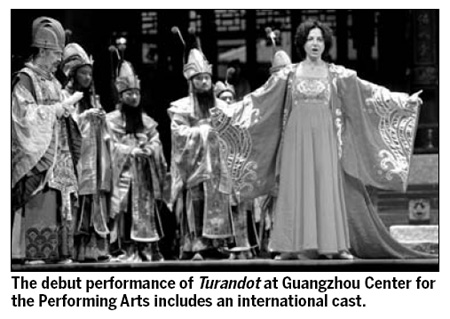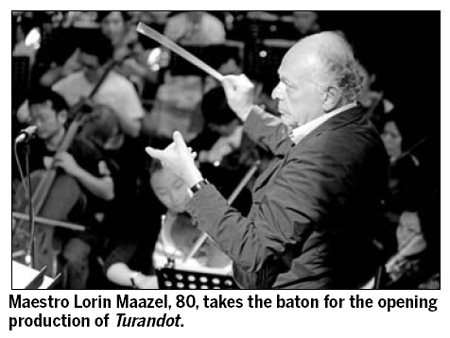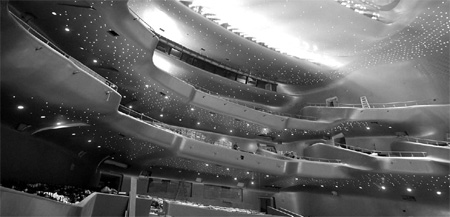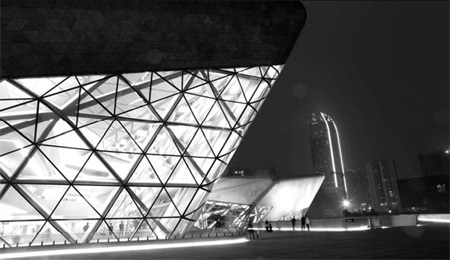Let the shows begin
|
The larger "twin boulder" of the Guangzhou Center for the Performing Arts houses a 1,800-seat theater. photos provided to China Daily |
|
The controversial Guangzhou Center for the Performing Arts by British Zaha Hadid. |
There were some who said it could never be built, but after seven years in the making, Guangzhou Center for the Performing Arts has raised the curtain for its debut performance. Chen Jie reports
Inspired by the boulders in the Pearl River (Zhujiang River) that runs through the city of Guangzhou, the British Zaha Hadid Architects won the bid to design the Guangzhou Opera House with its "twin boulder" design in November 2002.
Over the last seven years, the twin buildings, one white and one black, have taken shape in Zhujiang Boulevard.
Now the unique venue, which has changed its name to the Guangzhou Center for the Performing Arts, and which cost 1.38 billion yuan ($202 million), finally raised the curtain on Thursday evening with its debut performance, Puccini's opera Turandot.
The origins of the Guangzhou Center for the Performing Arts can be traced back to 1987, when the municipal government decided to develop a new city district on the northern bank of the Pearl River in order to alleviate the pressure on the city caused by a growing population.
Around the same time a Western consul in Guangzhou complained that such a big city did not have a nice theater or concert hall. The government decided to build an opera house in the new area, since they thought a prestigious opera house, like the Sydney Opera House, or New York's Metropolitan Opera, would symbolize the city's image as well as provide a world-class performing arts venue.
In 2002, the government released the design bids for the Guangzhou Opera House to the public and let the citizens choose what kind of opera house they would like. More than 20,000 people went to the exhibition and voted online. Hadid's "twin boulder" design won the most votes.
A folk song popular in Guangzhou asks: "Who laid the boulder in the middle of the river? It was God's blessing on the ancient city of Guangzhou."
Throughout Guangzhou's 2,000 year history, the boulders, which have been washed smooth and pearl-like by the rushing waves, have been adored by the locals and the Pearl River was named after them.
Guangzhou Opera House formally started construction in June 2003, but constructors soon found they faced a challenge.
Many of Hadid's avant-garde designs, such as that for the Cardiff Bay Opera House, were never realized, as they were considered too hard and expensive to deliver. Though that has never deterred her from pursuing her unique designs.
"From the structural steel point of view, it's more difficult than the Bird's Nest and CCTV's trouser leg project," says Yao Mingqiu, general manager of Guangdong Guangjian Project Management. "It's the most complex thing we've done. Not one wall is vertical to the ground. Not one of the cross sections of the facades of the buildings is the same as any other. Hadid's works feature incredible curves that go beyond anything anyone else would imagine. They look more like images in a dream or from the virtual world, and are almost impossible to build in the real world."
Due to the many construction difficulties and cost overruns, the Guangzhou Opera House started to receive a lot of criticism.
Some of the international press said that Guangzhou was trying to build something utterly crazy, while others stated that Hadid's weird design was meaningless, unless its purpose was to make construction more difficult and expensive.
But thanks to the perseverance and efforts of the Chinese constructor, Hadid's crazy design is now operational.
More than 10,000 tons of steel were used in its construction, double the amount used to build Beijing's National Center for the Performing Arts, and 5,100 pieces of glass. The bigger of the two "boulders" houses a 1,800-seat theater, 50 dressing rooms and a dozen balconies; while the smaller structure includes a 400-seat multi-function theater. The cafe, bar and retail facilities are located between them.
So the opera house was ready, but who was to manage it?
In early 2009, the Beijing-based China Arts and Entertainment Group (CAEG) won the bid to manage the new venue.
Backed by the Ministry of Culture, CAEG produces, exports and imports performing arts productions. In recent years it has also become involved in ticketing and theater management.
"As the economy booms and cultural events flourish in China, arts venues with modern facilities are mushrooming, not only in big cities like Beijing, Shanghai and Guangzhou, but many second and third tier towns. It's a great opportunity for us. Without a professional managing team, most of the theaters end up as the local governments' conference halls," says Zhang Yu, general manager of CAEG.
He says they wanted a flagship theater and as their bid to manage the National Center for the Performing Arts in Beijing failed, they decided the new Guangzhou Opera House was the best choice. On the other side, Guangzhou government had its eyes on CAEG's sources in the Ministry of Culture which would bring good productions.
"We did a careful marketing study and believe Guangzhou has a huge potential audience for the performing arts," says Li Yu, who used to be manager of CAEG's Tianqiao Theater in Beijing now is sent to Guangzhou to manage the new theater.
"Guangzhou people are wealthy and are willing to pay for entertainment. They will travel to Hong Kong just to see the full-length edition of Ang Lee's movie Lust, Caution. The very rich would pay artists to give private shows for families, friends and clients."
Before the new opera house, Guangzhou only had Xinghai Concert Hall and a few old theaters with shabby facilities, Li says. CAEG's plan is that the main theater will run regular seasons of classical opera, ballet, drama and concerts while the smaller theater, whose seats can be arranged in six different configurations, will serve as a multi-functional room where lectures, fashion shows, workshops, and even parties can be staged. According to Li, some 200 shows will run during 2010.
"We are now ready to present to the Guangzhou people a variety of high-quality shows that are of international standard and suit the local's tastes," Li says.
The opening production of Turandot was the one directed by the Chinese movie director Chen Kaige, in 2008, at the Palau de les Arts Reina Sofia, in Valencia. Chen does not direct the Guangzhou production, instead that honor goes to his associate director in Valencia, American Shahar Stroh.
"Chen is my mentor and close friend. He invited me to join his team in Valencia because I learned music and he needed someone who knows opera. I've learned much from him," Stroh says.
Stroh, set designer Liu Qing and costume designer Chen Tongxun, who were the designers for Chen's Valencia production, present a Turandot of extravagant colors and rich choreography.
"The story of Turandot can be interpreted in different ways. Similarly, China is a country interpreted by different people in different ways. In this sense, the opera fits today's China," says the director.
Under the baton of the 80-year-old maestro Lorin Maazel, an international cast including the French soprnao Sylvie Voize Dite Valayre as Turandot, soprano Cristina Gallardo-Domas as Liu, the Canadian tenor Richard Margison as Calaf and Chinese bartione Tian Haojiang as Timur, together with the 300 plus orchestra and chorus of the Shanghai Opera House, presented an impressive debut.
The show started on Thursday and will run till Sunday, when a formal opening ceremony will be held to launch the new theater's first season.


(China Daily 05/08/2010 page11)
















